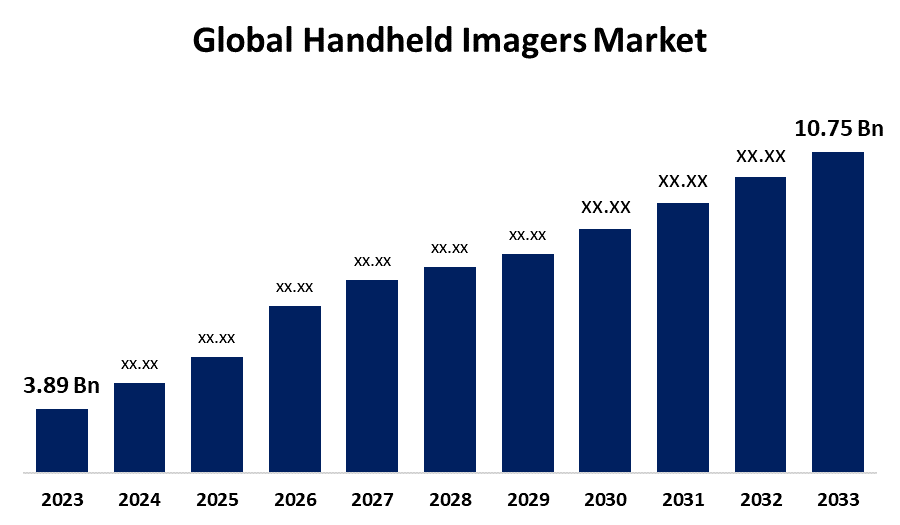Global Handheld Imagers Market Size, Share, and COVID-19 Impact Analysis, By Product (IR Scanners, Stud Finders, Millimeter Wave Scanner, Microbolometers, and Others), By Application (Construction, Industry, Security, Medical, and Others), Analysis and Forecast 2023 - 2033
Industry: Electronics, ICT & MediaGlobal Handheld Imagers Market Insights Forecasts to 2033
- The Global Handheld Imagers Market Size Was Estimated at USD 3.89 Billion in 2023
- The Market Size is Expected to Grow at a CAGR of around 10.7% from 2023 to 2033
- The Worldwide Handheld Imagers Market Size is Expected to Reach USD 10.75 Billion by 2033
- Asia Pacific is Expected to Grow the fastest during the forecast period.

Get more details on this report -
The Global Handheld Imagers Market Size Was Worth Around USD 3.89 Billion in 2023 and is predicted to Grow to around USD 10.75 Billion by 2033 with a CAGR of 10.7% between 2023 and 2033. Handheld Imagers are Expanding their utility in point-of-care testing and telemedicine applications.
Market Overview
The global handheld imagers market is the industry that deals with devices that have been designed to be portable for real-time imaging and scanning in various industries. These imagers can be rapidly deployed to emerging security threats. Handheld imagers with night vision, thermal imaging, and target acquisition capabilities are essential for surveillance, reconnaissance, and combat operations. Higher megapixel sensors were developed as the technology for sensor devices improved, leading to a better resolution for these images. This yields stronger and higher resolution images, crucial for medical diagnostics, industrial inspections, and applications in security surveillance. Advances in infrared, thermal, and multispectral imaging have expanded the capabilities and scope of these devices to offer clearer images along with increased detection opportunities. The integration of AI and ML algorithms has transformed the space of image analysis and interpretation. These technologies will enable automated and also more accurate diagnostics, reduce the chances of human errors, and accelerate decision-making processes. AI-driven advanced image processing and analysis also promote real-time analytics, predictive maintenance, and analytical capabilities, in turn making it more efficient and reliable for hand-held imagers.
Report Coverage
This research report categorizes the handheld imagers market based on various segments and regions forecasts revenue growth and analyzes trends in each submarket. The report analyses the key growth drivers, opportunities, and challenges influencing the handheld Imagers market. Recent market developments and competitive strategies such as expansion, type launch, development, partnership, merger, and acquisition have been included to draw the competitive landscape in the market. The report strategically identifies and profiles the key market players and analyses their core competencies in each sub-segment of the handheld imagers market.
Global Handheld Imagers Market Report Coverage
| Report Coverage | Details |
|---|---|
| Base Year: | 2023 |
| Market Size in 2023 : | USD 3.89 Billion |
| Forecast Period: | 2023-2033 |
| Forecast Period CAGR 2023-2033 : | 10.7% |
| 2033 Value Projection: | USD 10.75 Billion |
| Historical Data for: | 2019-2022 |
| No. of Pages: | 222 |
| Tables, Charts & Figures: | 110 |
| Segments covered: | By Product, By Application |
| Companies covered:: | BAE Systems, Fluke Corporation, Zoro Tools, Inc., Zebra Technologies Corp., Teledyne FLIR LLC, Leonardo DRS, General Dynamics Corporation, Robert Bosch GmbH, Raytek Direct, Opgal Optronics Industries Ltd., and Others |
| Pitfalls & Challenges: | Covid-19 Empact, Challenges, Growth, Analysis. |
Get more details on this report -
Driving Factors
The increasing demand for non-invasive diagnostic tools in healthcare is one of the main drivers of growth in the handheld imagers market. Advances such as AI and machine learning algorithms integrated into handheld imagers have further increased their capabilities. They allow real-time image analysis, automated anomaly detection, and pattern recognition, making them more versatile across sectors.
Restraining Factors
The most significant challenge and consideration in adopting and using handheld imagers in sectors such as healthcare, industrial automation, and security are the data security concerns. This is because the information collected and transmitted by these devices is sensitive and may have privacy implications.
Market Segmentation
The handheld imagers market share is classified into product and application.
- The stud finders segment accounted for the largest share in 2023 and is projected to grow at a significant CAGR during the forecast period.
Based on the product, the handheld imagers market is divided into IR scanners, stud finders, millimeter wave scanner, microbolometers, and others. Among these, the stud finders segment accounted for the largest share in 2023 and is projected to grow at a significant CAGR during the forecast period. The growth in the segment is due to the availability of affordable stud finders, it has become possible for diverse consumers, including DIY enthusiasts, small contractors, and large construction firms, to acquire them. This cost-effectiveness has led to the widespread use of these devices across various sectors.
The medical segment accounted for a significant share in 2023 and is anticipated to grow at the fastest CAGR during the forecast period.
Based on the application, the handheld imagers market is divided into construction, industry, security, medical, and others. Among these, the medical segment accounted for a significant share in 2023 and is anticipated to grow at the fastest CAGR during the forecast period. The growth in the segment is because the point-of-care availability of handheld imagers allows for immediate diagnostic capabilities, thereby helping healthcare providers make quick and accurate decisions in medical procedures. Such convenience and accessibility are very beneficial in emergency settings, rural areas, and home healthcare, where traditional imaging equipment may not be readily available.
Regional Segment Analysis of the Handheld Imagers Market
- North America (U.S., Canada, Mexico)
- Europe (Germany, France, U.K., Italy, Spain, Rest of Europe)
- Asia-Pacific (China, Japan, India, Rest of APAC)
- South America (Brazil and the Rest of South America)
- The Middle East and Africa (UAE, South Africa, Rest of MEA)
North America is anticipated to hold the largest share of the handheld imagers market over the predicted timeframe.

Get more details on this report -
North America is anticipated to hold the largest share of the handheld imagers market over the predicted timeframe. The regional growth can be attributed to the portability, flexibility, and convenience, which makes the users caption 3D data with accuracy and efficiency. The North American region is expected to grow further with the industrial demand for on-site data capture and real-time analysis, including architecture, engineering, and construction.
Asia Pacific is expected to grow at the fastest CAGR in the handheld imagers market during the forecast period. The growth in the region can be attributed to the diversified applications in different industries. The key utilization industries are automation, healthcare, manufacturing, and consumer electronics. The rising trend of automation, sustainability initiatives, and advanced technology is reshaping the market, which is causing the key players to enhance product offers. The demand for efficiency and performance is also increasing.
Competitive Analysis:
The report offers the appropriate analysis of the key organizations/companies involved within the handheld imagers market along with a comparative evaluation primarily based on their type of offering, business overviews, geographic presence, enterprise strategies, segment market share, and SWOT analysis. The report also provides an elaborative analysis focusing on the current news and developments of the companies, which includes type development, innovations, joint ventures, partnerships, mergers & acquisitions, strategic alliances, and others. This allows for the evaluation of the overall competition within the market.
List of Key Companies
- BAE Systems
- Fluke Corporation
- Zoro Tools, Inc.
- Zebra Technologies Corp.
- Teledyne FLIR LLC
- Leonardo DRS
- General Dynamics Corporation
- Robert Bosch GmbH
- Raytek Direct
- Opgal Optronics Industries Ltd.
- Others
Key Target Audience
- Market Players
- Investors
- End-users
- Government Authorities
- Consulting And Research Firm
- Venture capitalists
- Value-Added Resellers (VARs)
Recent Development
- In September 2024, NavVis, a service provider and enterprise to capture and share photorealistic digital twins, launched a new handheld scanner – the NavVis MLX. The product is designed to focus on data quality, portability, and user comfort. The MLX is fully compatible with standard tools in the field and can capture control points.
Market Segment
This study forecasts revenue at global, regional, and country levels from 2023 to 2033. Spherical Insights has segmented the handheld imagers market based on the below-mentioned segments:
Global Handheld Imagers Market, By Product
- IR Scanners
- Stud Finders
- Millimeter Wave Scanner
- Microbolometers
- Others
Global Handheld Imagers Market, By Application
- Construction
- Industry
- Security
- Medical
- Others
Global Handheld Imagers Market, By Regional Analysis
- North America
- US
- Canada
- Mexico
- Europe
- Germany
- UK
- France
- Italy
- Spain
- Russia
- Rest of Europe
- Asia Pacific
- China
- Japan
- India
- South Korea
- Australia
- Rest of Asia Pacific
- South America
- Brazil
- Argentina
- Rest of South America
- Middle East & Africa
- UAE
- Saudi Arabia
- Qatar
- South Africa
- Rest of the Middle East & Africa
Need help to buy this report?